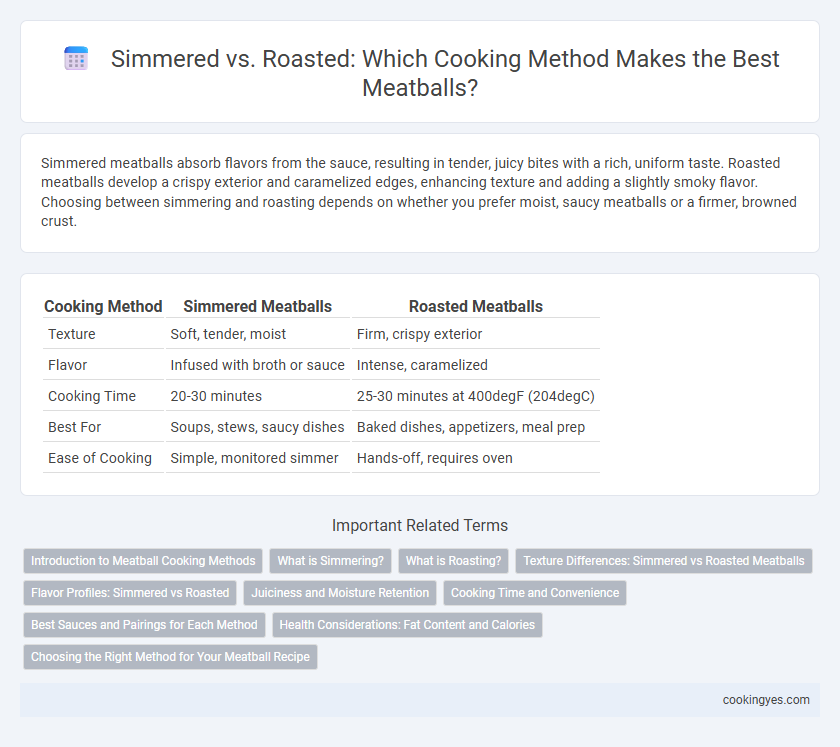Simmered meatballs absorb flavors from the sauce, resulting in tender, juicy bites with a rich, uniform taste. Roasted meatballs develop a crispy exterior and caramelized edges, enhancing texture and adding a slightly smoky flavor. Choosing between simmering and roasting depends on whether you prefer moist, saucy meatballs or a firmer, browned crust.
Table of Comparison
| Cooking Method | Simmered Meatballs | Roasted Meatballs |
|---|---|---|
| Texture | Soft, tender, moist | Firm, crispy exterior |
| Flavor | Infused with broth or sauce | Intense, caramelized |
| Cooking Time | 20-30 minutes | 25-30 minutes at 400degF (204degC) |
| Best For | Soups, stews, saucy dishes | Baked dishes, appetizers, meal prep |
| Ease of Cooking | Simple, monitored simmer | Hands-off, requires oven |
Introduction to Meatball Cooking Methods
Simmered meatballs absorb flavors from broths or sauces, resulting in a tender texture ideal for dishes like Italian wedding soup. Roasted meatballs develop a caramelized exterior with a firmer bite, enhancing flavor through dry heat and Maillard reactions. Choosing between simmering and roasting depends on the desired taste profile and moisture level in the final dish.
What is Simmering?
Simmering meatballs involves cooking them gently in a liquid just below boiling, typically at 185degF to 205degF (85degC to 96degC), which ensures tender, evenly cooked results and enhances flavor absorption. This method contrasts with roasting, which uses dry, high heat to develop a browned, crispy exterior but can risk drying out the interior. Simmering in sauces like marinara or broth allows meatballs to remain moist while infusing rich, savory tastes throughout the cooking process.
What is Roasting?
Roasting meatballs involves cooking them in an oven at high, dry heat, which creates a crispy, browned exterior while locking in juices for a tender interior. This method enhances the flavor through caramelization and Maillard reactions, resulting in a richer, more intense taste compared to simmering. Roasted meatballs typically offer a firmer texture and are ideal for recipes that benefit from a crisp crust, such as baked pasta dishes or meatball sandwiches.
Texture Differences: Simmered vs Roasted Meatballs
Simmered meatballs develop a tender, juicy texture as they slowly cook in liquid, allowing flavors to meld and the meat to remain moist. Roasted meatballs create a firmer exterior with a caramelized crust, offering a contrast between the crunchy outside and a denser interior. The choice between simmering and roasting significantly impacts the final texture, with simmering producing softness and roasting enhancing crispness.
Flavor Profiles: Simmered vs Roasted
Simmered meatballs develop a tender texture and absorb surrounding flavors, resulting in a juicy, mildly spiced profile enhanced by herbs and sauce. Roasted meatballs gain a caramelized, crispy exterior and concentrated, bold taste with deeper browning and intensified meatiness. The choice between simmered and roasted methods significantly affects the overall flavor complexity and mouthfeel of meatballs.
Juiciness and Moisture Retention
Simmered meatballs retain moisture exceptionally well, resulting in a tender, juicy texture as the gentle heat prevents moisture loss during cooking. Roasted meatballs develop a flavorful crust but tend to lose more moisture, which can lead to a drier interior if not carefully monitored. For optimal juiciness, simmering maintains moisture retention better than roasting, making it ideal for soft and succulent meatballs.
Cooking Time and Convenience
Simmering meatballs typically takes 20 to 30 minutes, allowing them to cook evenly while absorbing flavorful liquids, making it an ideal method for soups and sauces. Roasting meatballs usually requires 15 to 20 minutes at 400degF, providing a quicker cooking time with a crispy exterior and less hands-on attention. Simmering offers convenience through one-pot cooking, whereas roasting allows for batch preparation and easy cleanup on a baking sheet.
Best Sauces and Pairings for Each Method
Simmered meatballs absorb rich tomato-based or creamy sauces like marinara or vodka sauce, enhancing their tender texture and melding flavors perfectly. Roasted meatballs develop a caramelized crust ideal for pairing with bold, smoky barbecue or tangy mustard-based sauces that complement their robust taste. Choosing simmering emphasizes moisture and sauce infusion, while roasting highlights texture and deeper flavor profiles suited for hearty accompaniments.
Health Considerations: Fat Content and Calories
Simmered meatballs retain less fat as excess grease drains into the liquid, resulting in lower calorie content and a leaner dish compared to roasting. Roasted meatballs often have a higher fat concentration since the fat renders but remains within the meatball, increasing calories and saturated fat intake. Choosing simmered meatball preparation supports healthier eating habits by minimizing overall fat consumption and promoting lower caloric meals.
Choosing the Right Method for Your Meatball Recipe
Simmered meatballs retain moisture and develop a tender texture, ideal for recipes featuring rich sauces or soups. Roasted meatballs offer a firmer, caramelized exterior and enhanced browning, perfect for dishes requiring a crispy finish or grilling. Selecting the right method depends on your desired texture and flavor profile, balancing moisture retention versus Maillard reaction development.
Simmered vs Roasted for Meatball Cooking Method Infographic

 cookingyes.com
cookingyes.com